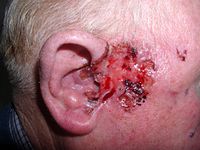
Photo from wikipedia
Previous studies evaluating association between circulating tumor cells (CTCs) and clinical outcomes in hepatocellular carcinoma (HCC) have shown inconsistent results due to suboptimal detection methods and patient heterogeneity. Patients undergoing… Click to show full abstract
Previous studies evaluating association between circulating tumor cells (CTCs) and clinical outcomes in hepatocellular carcinoma (HCC) have shown inconsistent results due to suboptimal detection methods and patient heterogeneity. Patients undergoing surgery for early-stage HCC were prospectively enrolled. The CTC numbers were determined using a tapered slit platform, which detects CTCs based on the cell size and morphology. Survival and recurrence were evaluated, and Cox proportional hazards models were used to demonstrate the prognostic significance of CTC. Of 105 patients, 25 had increased CTC numbers after surgery (ΔCTC > 0, defined as positive) and a significantly higher level of recurrence (p = 0.042). A positive ΔCTC was seen to be an independent predictor of recurrence (hazard ratio 2.28), along with hepatitis B virus infection, alanine aminotransferase level, and the presence of satellite nodules (all p < 0.05). Subgroup analyses showed that a positive ΔCTC was associated with lower survival and higher recurrence among patients with low alpha-fetoprotein levels and cirrhosis (all p < 0.05). Calculation of ΔCTC based on the physical properties of the cells is predictive of recurrence in patients with early HCC undergoing surgery.
Journal Title: Hepatology International
Year Published: 2019
Link to full text (if available)
Share on Social Media: Sign Up to like & get
recommendations!